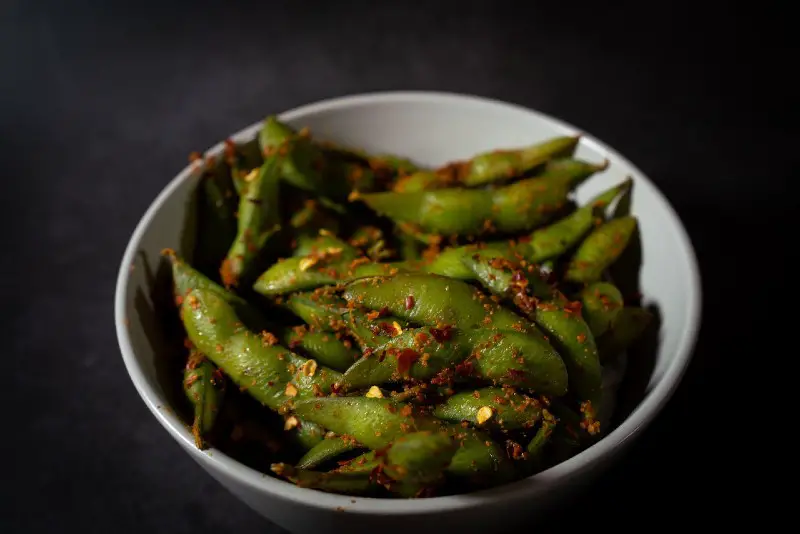What Does Edamame Taste Like?
Quick Answer
Edamame has a mild, nutty, and slightly sweet flavor, somewhat similar to fresh peas. The texture is firm but tender, offering a satisfying bite. Many people enjoy them steamed or boiled and sprinkled with salt, although their flavor can also be enhanced with various seasonings and spices.
What is Edamame?
Edamame are immature soybeans, harvested before they have had a chance to harden. They are usually green and still encased in their pods.
Commonly found in East Asian cuisines, edamame is often steamed or boiled and served as a snack or side dish, frequently sprinkled with salt.
They are also rich in protein, fiber, and various vitamins and minerals, making them a nutritious food choice.
What Does Edamame Taste Like?
If you’ve never tried edamame before, you’re likely curious about its flavor. At its core, edamame has a very approachable taste profile.
It is mild, which means it’s not overwhelming to the palate, but it also has layers of nuttiness and a slight sweetness that make it a fascinating subject for your taste buds.
This trio of mild, nutty, and slightly sweet notes creates a balance that makes edamame both a great standalone snack and a versatile ingredient in a wide range of dishes.
Comparison to Other Foods
When it comes to comparing edamame to other foods, fresh green peas often come to mind. Both have that garden-fresh greenness and slight sweetness.
However, edamame is nuttier and has a more robust texture than green peas, which can be mushier.
Also, because edamame is a young soybean, it has similarities to mature soybeans but is more tender and less intensely “beany” in flavor.
What is The Texture Of Edamame Like?
One of the appealing features of edamame is its delightful texture. The pods themselves are somewhat fibrous and not meant for consumption, but once you pop out the beans, you’re greeted with a firm yet tender bite. The beans have enough structural integrity to offer a satisfying “pop” when bitten into, yet they are tender enough to chew easily. This texture makes them ideal for snacking, as they engage your mouth in a tactile experience that’s different from mushy or overly crunchy snacks.
How Texture Complements The Taste
Texture plays a significant role in how we perceive taste, and in the case of edamame, the firm but tender texture wonderfully complements its mild, nutty, and slightly sweet flavor profile.
The nuttiness seems even more pronounced thanks to the bean’s firm outer skin, and the tenderness of the interior allows for the mild and slightly sweet notes to be fully enjoyed without being overshadowed by a tough or mushy texture.
FAQs
Is Edamame Similar To Peas?
Yes, edamame has a taste and texture that are somewhat similar to fresh green peas. However, edamame is nuttier and has a firmer texture than peas.
Does Cooking Method Affect The Taste of Edamame?
Yes, the cooking method can impact the taste and texture of edamame. Steaming generally retains the bean’s natural flavors better than boiling, but both methods are commonly used.
Can You Flavor Edamame With Spices Or Sauces?
Absolutely! Edamame can be seasoned with a variety of spices like garlic powder, chili flakes, or even tossed in sauces like soy or teriyaki to enhance its natural flavor.
Do Frozen And Fresh Edamame Taste Different?
There might be slight variations in taste and texture between frozen and fresh edamame, but generally, frozen edamame does a good job of preserving the bean’s natural flavors. Just make sure to cook frozen edamame thoroughly.
Does The Age Of The Edamame Affect Its Taste?
Yes, fresher edamame usually has a more vibrant taste and better texture. Older or stale edamame can lose its natural sweetness and become more fibrous.
How Does Salt Impact The Flavor Of Edamame?
A light sprinkling of salt can accentuate the natural flavors of edamame, making it even more enjoyable. The salt helps to bring out the nutty and sweet aspects of the bean.
Can I Eat Edamame Raw?
It’s generally not recommended to eat edamame beans raw due to the risk of bacterial contamination. Additionally, cooking edamame makes its proteins more digestible and its nutrients more bioavailable. Most people consume edamame beans that have been steamed or boiled, which also enhances their flavor.
Does Edamame Taste Like Tofu?
While both edamame and tofu are soy-based, their flavors are quite different. Tofu has a more neutral taste and a softer texture, while edamame has a distinctive nutty and slightly sweet flavor with a firm but tender texture.
Can You Eat Edamame Shells?
Edamame shells, or pods, are generally not eaten as they are tough and fibrous. The common way to consume edamame is to squeeze the beans out of the pods directly into your mouth or hand. However, the pods can be used to make broths or added to compost.
Can Edamame Beans be Eaten as Snacks?
Absolutely! One of the most popular ways to enjoy edamame is as a snack. The beans are often steamed or boiled and then sprinkled with a bit of salt. Their firm but tender texture and mild, nutty, slightly sweet flavor make them a satisfying and nutritious option for snacking.
Do Edamame Beans Taste Like Broad Beans?
While both edamame and broad beans are legumes with a green color and similar shape, their flavors are different. Broad beans have a stronger, more earthy taste, whereas edamame has a milder, nuttier, and slightly sweet flavor.
Do Edamame Beans Taste Like Fava Beans?
Fava beans and edamame do have some similarities, as both offer a sort of nuttiness and green, vegetal flavor. However, fava beans are usually more buttery and have a more pronounced earthy taste compared to the milder edamame.
Do Edamame Beans Taste Like Lima Beans?
Edamame and lima beans are different both in texture and flavor. Lima beans have a starchy, somewhat buttery flavor and can be quite soft when cooked. Edamame, on the other hand, are firmer, nuttier, and have a slight sweetness that lima beans usually lack.
What Tastes Similar to Edamame Beans?
The closest comparison in terms of taste to edamame beans would likely be fresh green peas or perhaps young, tender fava beans. However, edamame’s unique combination of mild, nutty, and slightly sweet flavors makes it distinct.
What Flavors Can You Pair with Edamame?
Edamame is versatile and pairs well with a variety of flavors. For savory options, consider garlic, soy sauce, or even truffle oil. If you prefer a spicy kick, chili flakes or sriracha work well. For a sweeter touch, you can try tossing edamame with a bit of sesame oil and honey. Its mild flavor also allows it to work well in both Asian and Western culinary contexts.


